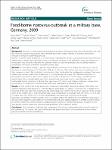Food-borne norovirus-outbreak at a military base, Germany, 2009
Wadl, Maria
Scherer, Kathrin
Nielsen, Stine
Diedrich, Sabine
Ellerbroek, Lüppo
Frank, Christina
Gatzer, Renate
Hoehne, Marina
Johne, Reimar
Klein, Günter
Koch, Judith
Schulenburg, Jörg
Thielbein, Uta
Stark, Klaus
Bernard, Helen
Background: Norovirus is often transmitted from person-to-person. Transmission may also be food-borne, but only few norovirus outbreak investigations have identified food items as likely vehicles of norovirus transmission through an analytical epidemiological study. During 7-9 January, 2009, 36 persons at a military base in Germany fell ill with acute gastroenteritis. Food from the military base’s canteen was suspected as vehicle of infection, norovirus as the pathogen causing the illnesses. An investigation was initiated to describe the outbreak’s extent, to verify the pathogen, and to identify modes of transmission and source of infection to prevent further cases. Methods: For descriptive analysis, ill persons were defined as members of the military base with acute onset of diarrhoea or vomiting between 24 December 2008, and 3 February 2009, without detection of a pathogen other than norovirus in stools. We conducted a retrospective cohort study within the headquarters company. Cases were military base members with onset of diarrhoea or vomiting during 5-9 January. We collected information on demographics, food items eaten at the canteen and contact to ill persons or vomit, using a self-administered questionnaire. We compared attack rates (AR) in exposed and unexposed persons, using bivariable and multivariable logistic regression modelling. Stool specimens of ill persons and canteen employees, canteen food served during 5-7 January and environmental swabs were investigated by laboratory analysis. Results: Overall, 101/815 (AR 12.4%) persons fell ill between 24 December 2008 and 3 February 2009. None were canteen employees. Most persons (n = 49) had disease onset during 7-9 January. Ill persons were a median of 22 years old, 92.9% were male. The response for the cohort study was 178/274 (72.1%). Of 27 cases (AR 15.2%), 25 had eaten at the canteen and 21 had consumed salad. Salad consumption on 6 January (aOR: 8.1; 95%CI: 1.5-45.4) and 7 January (aOR: 15.7; 95%CI: 2.2-74.1) were independently associated with increased risk of disease. Norovirus was detected in 8/28 ill persons’ and 4/25 canteen employees’ stools, 6/55 environmental swabs and 0/ 33 food items. Sequences were identical in environmental and stool samples (subtype II.4 2006b), except for those of canteen employees. Control measures comprised cohort isolation of symptomatic persons, exclusion of norovirus- positive canteen employees from work and disinfection of the canteen’s kitchen. Conclusions: Our investigation indicated that consumption of norovirus-contaminated salad caused the peak of the outbreak on 7-9 January. Strict personal hygiene and proper disinfection of environmental surfaces remain crucial to prevent norovirus transmission.
Dateien zu dieser Publikation
Keine Lizenzangabe

